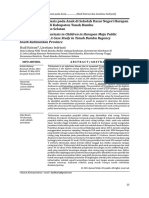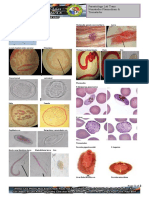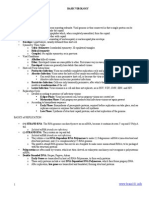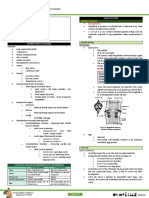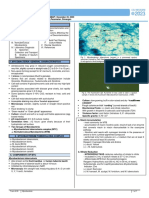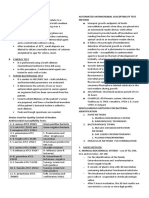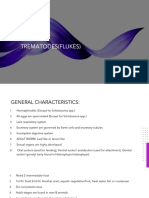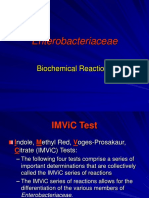Nematodes: 2. Enterobius Vermicularis
Nematodes: 2. Enterobius Vermicularis
Uploaded by
Cia QuebecCopyright:
Available Formats
Nematodes: 2. Enterobius Vermicularis
Nematodes: 2. Enterobius Vermicularis
Uploaded by
Cia QuebecOriginal Title
Copyright
Available Formats
Share this document
Did you find this document useful?
Is this content inappropriate?
Copyright:
Available Formats
Nematodes: 2. Enterobius Vermicularis
Nematodes: 2. Enterobius Vermicularis
Uploaded by
Cia QuebecCopyright:
Available Formats
NEMATODES
QUEBEC, C
Fatal effects: erratic migration
Common name: Roundworms 2. Enterobius vermicularis
General Characteristics Common name: Pinworm/ Seatworm
Non-segmented Mode of Transmission: Ingestion of embryonated egg
Cylindrical Egg: Transparent and D-shaped
Tapered at both ends Infective Stage: Embryonated egg
Covered by a protective covering or cuticle Diagnostic Stage: Fertilized and unfertilized egg
Presence of muscle fibers: line the body cavity -in the perianal folds: females go to the anal
(Pseudocoelom) openings to lay eggs and they die after. Larvae
Body cavity contains: viscera, digestive, inside eggs mature in 4-6 hours.
excretory, nervous, and reproductive systems
Sexes are separate Diagnosis: Graham scotch tape swab
Morphology:
Female adult: Some are: Egg: D-shaped, one side flattened, the other convex,
Oviparous: egg-laying transparent shell
Viviparous: Larvae
Parthenogenesis: virgin birth (S. stercoralis) Adult: cuticular alar expansions of the anterior and
prominent posterior esophageal bulb. Males are rarely
Larval stage seen, female dies after deposition.
-for strongyloides and hookworm
Rhabditiform Pathology: Perianal itching/pruritus ani: can lead to
Filariform secondary bacterial infection
-Vaginitis, endometriosis, salpingitis
NEMATODE SPECIES Insomnia, poor appetite, weight loss, irritability, grinding
of teeth, abdominal pain
1. Ascaris lumbricoides 3. Trichuris trichiura
Common name: Giant intestinal roundworm Common name: Whipworm
Mode of Transmission: Ingestion of embryonated egg Infective Stage: Embryonated egg
Infective Stage: Embryonated egg Diagnostic Stage: unembryonated egg
Diagnostic Stage: Fertilized and unfertilized egg Habitat: : Large intestine/cecum
Intermediate host: None
Habitat: Small intestine Morphology:
Migrate to the lungs as a larvae Egg: lemon-shaped/football-shaped
Morphology: Adult entire whip-like portion is deeply embedded into
Egg: fertilized egg has outer coarsely mammillated the intestinal wall of the cecum
albuminous covering (corticated)
Pathology: P etechial hemorrhages
Adult: worms have 3 lips, females are larger than Rectal prolapse
males, females: pointed end, males: curved posterior No larval migration
ends
4. Hookworm
Pathology: 2 kinds- differentiated with the buccal cavity
Tissue reaction to the invading larvae Facultative parasite: no need for an intermediate
Intestinal irritation (adult worm) host
Other complications due to extraintestinal migration
Lungs: allergic manifestations (i.e. asthma) Ancylostoma duodenale
Loefflers syndrome Old world hookworm
Buccal cavity: 2 pairs of ventral teeth
Necator americanus Muscle invasion phase: fever, eosinophilia, circumorbital
New world hookworm edema, muscle pain, CNS involvement
Buccal cavity: 2 pairs of semilunar
cutting plates
Mode of Transmission: Skin penetration 8. Filarial worms
Infective Stage: Filariform larvae
Diagnostic Stage: Eggs Brugia malayi
Pathology: Ground itch
Lung migration - bronchitis, pneumonitis Common name: Malayan filarial worm
Chronic: microcytic, hypochromic iron deficiency anemia, Habitat: Lymph vessels and lymph glands
hypoalbuminemia Vector: Mansonia
Wuchereria bancrofti
5. Strongyloides stercoralis
Facultative parasite Common name: bancrofti filarial worm
Vector: anopheles and aedes mosquito
Common name: Threadworm
Habitat: Esophagus Mode of Transmission: bite of mosquito
Infective Stage: Filariform larvae Infective Stage: L3 larvae
Diagnostic Stage: Rhabditiform larvae Diagnostic Stage: Microfilaria in the blood (IS of the
-Rhabditiform can be differentiated from the mosquito)
adult by its size in the esophagus Pathology: Lymphadenitis, swelling and redness of
arms and legs
Pathology: Chronic: asymptomatic with occasional Elephantiasis, hydrocoele
exacerbations
Acute: urticaria, abdominal pains, diarrhea, Dx: Lab dx: microscoping finding of characteristic
malabsorption, hypoalbuminemia microfilariae in the blood (8 pm - 4 am)
Disseminated: occurs in immunocompromised Knotts method (filtration),k Antigen detecting methods
individuals, fatal may involve vital organs (ELISA, PCR, Ultrasonography)
6. Capillaria philippinensis
Common name: Pudoc worm
Intermediate host: Fish
Reservoir: bird
Habitat: Small intestine
Mode of Transmission: Ingestion of infected fish
Infective Stage: larvae
Diagnostic Stage: embryonated/Unembryonated egg
Pathology: Abdominal pains, gurgling stomach
(borborygmus), diarrhea
Severe protein losing, malabsorption of fats, low
electrolyte count, high level of IgE
Micro ulcers in epithelium
7. Trichinella spiralis
Common name: Trichina worm
Mode of Transmission: Ingestion of undercooked meat
Habitat: Gastrocnemius muscle
Infective Stage: Encysted larvae
Diagnostic Stage Encysted larvae
Pathology: Intestinal phase: non specific gastroenteritis
You might also like
- Sir Alvin Rey Flores: Echinococcus Granulosus, Taenia Solium)Document5 pagesSir Alvin Rey Flores: Echinococcus Granulosus, Taenia Solium)Corin LimNo ratings yet
- Species Common/Other Name Pathogenesis Mot/Infective Stage Diagnostic Stage I. NematodesDocument2 pagesSpecies Common/Other Name Pathogenesis Mot/Infective Stage Diagnostic Stage I. NematodesautumntreesNo ratings yet
- Classification of NematodesDocument3 pagesClassification of Nematodesshahbaz zafar100% (1)
- Prevalence of Trichuriasis in Children in Harapan Maju Public Elementary School: A Case Study in Tanah Bumbu Regency South Kalimantan ProvinceDocument8 pagesPrevalence of Trichuriasis in Children in Harapan Maju Public Elementary School: A Case Study in Tanah Bumbu Regency South Kalimantan ProvinceFaaNo ratings yet
- Para-Transes Prelim Exam - Unit 2Document20 pagesPara-Transes Prelim Exam - Unit 2Aysha AishaNo ratings yet
- Trematodes: Blood FlukesDocument3 pagesTrematodes: Blood FlukesFrance Louie JutizNo ratings yet
- Myco Viro Possible QuestionsDocument14 pagesMyco Viro Possible QuestionsDhanimie FayeNo ratings yet
- Medical Parasitology: Medina & Albano - Lecture & LaboratoryDocument9 pagesMedical Parasitology: Medina & Albano - Lecture & LaboratoryabigailNo ratings yet
- Parasitology Lab ManualDocument33 pagesParasitology Lab ManualshericeNo ratings yet
- Amoeba and CestodesDocument5 pagesAmoeba and Cestodes2013SecB100% (1)
- Nematodes: Specie Infecti VE Stage Diagnos TIC Stage Morphology Pathogen Esis Diagnosi S Treatme NT Life CycleDocument4 pagesNematodes: Specie Infecti VE Stage Diagnos TIC Stage Morphology Pathogen Esis Diagnosi S Treatme NT Life CycleMarinelle TumanguilNo ratings yet
- Cestodes Summary FinalsDocument2 pagesCestodes Summary FinalsKenneth Jake Batiduan100% (1)
- Morphologic Differences Cestodes (Tapeworms) Trematodes (Flukes) Nematodes (Roundworms)Document15 pagesMorphologic Differences Cestodes (Tapeworms) Trematodes (Flukes) Nematodes (Roundworms)Noelle Grace Ulep BaromanNo ratings yet
- Lec 1 - IntroductionDocument3 pagesLec 1 - IntroductionHaendra Mae DapilagaNo ratings yet
- ParaDocument73 pagesParaeasysleezeNo ratings yet
- Helminth 3Document2 pagesHelminth 3Farlogy100% (6)
- 2.1 MalariaDocument10 pages2.1 MalariaNeil Gabriel EncinaNo ratings yet
- Opportunistic MycosesDocument3 pagesOpportunistic MycosesMary100% (1)
- Mycology 1 PrelimDocument4 pagesMycology 1 PrelimKaye Angel VillonNo ratings yet
- Summary Table - TrematodesDocument4 pagesSummary Table - TrematodesNeil Joshua SuyatNo ratings yet
- Nematodes, Plasmodium and Trematodes LabDocument2 pagesNematodes, Plasmodium and Trematodes Lab2013SecBNo ratings yet
- 2 Parasitology Parasitic AmoebasDocument8 pages2 Parasitology Parasitic Amoebasknkjn100% (1)
- Tabel HelminthsDocument2 pagesTabel HelminthsMaria AgathaNo ratings yet
- CestodesDocument4 pagesCestodesmrcveight100% (1)
- MMQC ViroDocument12 pagesMMQC ViroFrancisJr Rodrigo RasonableNo ratings yet
- Systemic Mycoses: BlastomycosisDocument4 pagesSystemic Mycoses: BlastomycosisMary ChristelleNo ratings yet
- RMTnotes PARASITOLOGYDocument68 pagesRMTnotes PARASITOLOGYArvin O-CaféNo ratings yet
- 7.2 Laboratory Methods For Antimicrobial Susceptibility TestingDocument5 pages7.2 Laboratory Methods For Antimicrobial Susceptibility TestingprincessNo ratings yet
- PDFDocument4 pagesPDFNatalie EnriquezNo ratings yet
- Parasitology OspeDocument166 pagesParasitology OspePuvana Puvana100% (1)
- Fasciolopsis Buski: F Hepatica F. BuskiDocument4 pagesFasciolopsis Buski: F Hepatica F. BuskiGela ReyesNo ratings yet
- Lecture 10 Vibrio, Aeromonas, Campylobacter and HelicobacterDocument4 pagesLecture 10 Vibrio, Aeromonas, Campylobacter and HelicobacterRazmine RicardoNo ratings yet
- MycoViro 2Document44 pagesMycoViro 2Ria Alcantara100% (2)
- Virology ReviewDocument21 pagesVirology ReviewfrabziNo ratings yet
- ParasitologyLec 3 Nematodes 2 PDFDocument6 pagesParasitologyLec 3 Nematodes 2 PDFDJ RelojNo ratings yet
- Trematodes Schistosoma Spp. General CharacteristicsDocument3 pagesTrematodes Schistosoma Spp. General CharacteristicsGlenn PerezNo ratings yet
- 18 Staphylococci, Streptococci, Meningococci, GonococciDocument72 pages18 Staphylococci, Streptococci, Meningococci, GonococciManisanthosh KumarNo ratings yet
- Serologic Tests Part 3Document2 pagesSerologic Tests Part 3Joshua TrinidadNo ratings yet
- Introduction To Cestodes and Minor CestodesDocument8 pagesIntroduction To Cestodes and Minor CestodesJustin TayabanNo ratings yet
- Bacteriology PDFDocument49 pagesBacteriology PDFKat JornadalNo ratings yet
- 10 Anti InfectivesDocument29 pages10 Anti InfectivesFrançoise BNo ratings yet
- Mycobacteria: Nocardia, Rhodococcus, Tsukamurella and GordoniaDocument7 pagesMycobacteria: Nocardia, Rhodococcus, Tsukamurella and Gordonia20C – Gorospe, Rhai Chezka V.100% (1)
- Laboratory Evaluation of PlateletsDocument5 pagesLaboratory Evaluation of PlateletsDennis ValdezNo ratings yet
- Laboratory Manual CoverDocument2 pagesLaboratory Manual CoverMartin ClydeNo ratings yet
- Automated Antimicrobial Susceptibility Test MethodDocument2 pagesAutomated Antimicrobial Susceptibility Test MethodJoshua TrinidadNo ratings yet
- Malarial ParasitesDocument27 pagesMalarial ParasitesHANNAH SHALOM FERNANDEZNo ratings yet
- Immunology & Serology Week 1Document2 pagesImmunology & Serology Week 1Romie SolacitoNo ratings yet
- Methods of Studying Fungi: Dr. Alice Alma C. BungayDocument74 pagesMethods of Studying Fungi: Dr. Alice Alma C. BungayKaycee Gretz LorescaNo ratings yet
- Pre 1 MibrobiologyDocument3 pagesPre 1 MibrobiologyDeannise AnnNo ratings yet
- Ceratopogonidae (Leptoconops, Nil-Nik)Document4 pagesCeratopogonidae (Leptoconops, Nil-Nik)Dylan Warmfuzzies Sales100% (1)
- Week 2 Chemical Examination of UrineDocument44 pagesWeek 2 Chemical Examination of UrineDayledaniel SorvetoNo ratings yet
- Parasitology NotesDocument5 pagesParasitology NotesAyaAlforque100% (1)
- PROTOZOAN Part 2Document1 pagePROTOZOAN Part 2Meccar Moniem H. ElinoNo ratings yet
- Medical MycologyDocument1 pageMedical MycologyHairul AnuarNo ratings yet
- P. Vivax DiagnosisDocument4 pagesP. Vivax DiagnosisCynthia TerryNo ratings yet
- TREMATODESDocument31 pagesTREMATODESKen Mark ConcepcionNo ratings yet
- Enterobacteriaceae: Biochemical ReactionsDocument20 pagesEnterobacteriaceae: Biochemical Reactionslindaprihastiwi100% (1)
- Smallest Viruses (The Only Dna Virus To Have Ssdna) .: Parvovirus B19Document8 pagesSmallest Viruses (The Only Dna Virus To Have Ssdna) .: Parvovirus B19AfreenNo ratings yet
- Trematodes PDFDocument46 pagesTrematodes PDFAsnorah SaripNo ratings yet
- Mycobacteria: Molecular Biology and VirulenceFrom EverandMycobacteria: Molecular Biology and VirulenceC. RatledgeNo ratings yet
- Practical Manual for Detection of Parasites in Feces, Blood and Urine SamplesFrom EverandPractical Manual for Detection of Parasites in Feces, Blood and Urine SamplesNo ratings yet
- Blood Bank Technology Specialist - The Comprehensive Guide: Vanguard ProfessionalsFrom EverandBlood Bank Technology Specialist - The Comprehensive Guide: Vanguard ProfessionalsNo ratings yet
- Helminthic Infections. IdsDocument81 pagesHelminthic Infections. Idsdairymilk.weNo ratings yet
- Medical Parasitology QuestionsDocument6 pagesMedical Parasitology QuestionsIdrissa ContehNo ratings yet
- Morfologi Telur Dan Larva 2 Ascaridia Galli Pada Ayam KampungDocument5 pagesMorfologi Telur Dan Larva 2 Ascaridia Galli Pada Ayam KampungJuliu SamasNo ratings yet
- Group 2 Adenophorea PDFDocument21 pagesGroup 2 Adenophorea PDFSang SungNo ratings yet
- Helminth UsusDocument67 pagesHelminth UsusAnonymous unieGDNo ratings yet
- Revised Nematodes Specimens With Labels 2NMT Moving PracticalsDocument45 pagesRevised Nematodes Specimens With Labels 2NMT Moving PracticalsRudolph MendozaNo ratings yet
- Para Lab Helminthes PDFDocument67 pagesPara Lab Helminthes PDFAdriane BasaNo ratings yet
- Migs NematodesDocument61 pagesMigs NematodesJonas Datu100% (1)
- Klasifikasi HelminthesDocument2 pagesKlasifikasi HelminthesNabila EdwardNo ratings yet
- Parasitology All Questions & Suggested AnswersDocument55 pagesParasitology All Questions & Suggested AnswersQwami AtoNo ratings yet
- 144-Article Text-566-1-10-20180817Document14 pages144-Article Text-566-1-10-20180817Hekter Gunting KursiNo ratings yet
- Nematode ClassificationDocument4 pagesNematode ClassificationBimal BinoyNo ratings yet
- Systematic Classification of HelminthsDocument3 pagesSystematic Classification of HelminthsthyezlianNo ratings yet
- Nematodes LabDocument12 pagesNematodes LabJhana SamsonNo ratings yet
- Ekor Jantan: Brugia Malayi Mikrofilaria Brugia Timori Mikrofilaria Wuchereria Bancrofti MikrofilariaDocument9 pagesEkor Jantan: Brugia Malayi Mikrofilaria Brugia Timori Mikrofilaria Wuchereria Bancrofti MikrofilariavindychanNo ratings yet
- Nematodes For Quiz 1 RevisedDocument6 pagesNematodes For Quiz 1 RevisedAra NuesaNo ratings yet
- Ascaris, Trichuris, Oxyuris, Hookworm-2Document55 pagesAscaris, Trichuris, Oxyuris, Hookworm-2Mario EllNo ratings yet
- Pin WormDocument4 pagesPin WormDiana Laura LeiNo ratings yet
- NematodesDocument110 pagesNematodesRussel Bob BorromeoNo ratings yet
- Nematode TableDocument16 pagesNematode TableJackie Lind TalosigNo ratings yet
- Kti AgnesDocument46 pagesKti AgnesHidayat HafidzNo ratings yet
- Online Exam - Parasitology Part 2Document47 pagesOnline Exam - Parasitology Part 2qnx6696m7fNo ratings yet
- Jurnal Artikel Aau 1 PDFDocument7 pagesJurnal Artikel Aau 1 PDFRizkiSeptiaNo ratings yet
- Catatan ParasitologiDocument4 pagesCatatan ParasitologiAlicya BriaNo ratings yet
- ASCP PARASITOLOGY iMAGESDocument5 pagesASCP PARASITOLOGY iMAGESmelowinsierraNo ratings yet
- Ancylostomatidae, T.trichura, S.stercoralisDocument19 pagesAncylostomatidae, T.trichura, S.stercoralisIqrinawidyazaharaNo ratings yet
- Basic Science ParasitDocument33 pagesBasic Science ParasitNaifahLuthfiyahPutriNo ratings yet
- FilariasisDocument37 pagesFilariasisPutri Widya LarassatiNo ratings yet



